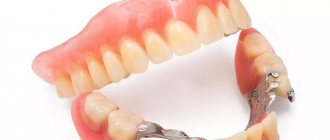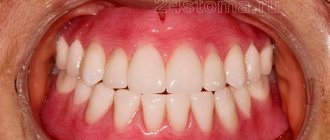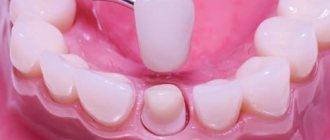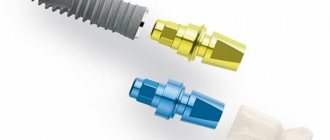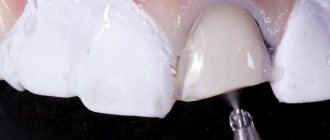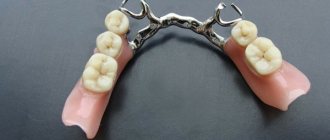What is clasp prosthetics?
A distinctive feature of the clasp is comfortable wearing, which is achieved thanks to the reduced volume and thickness of the base.
A clasp denture is one of the types of removable structures, the basis of which is a metal arch with plastic fragments imitating gums and artificial teeth fixed on it.
A clasp is a metal arch that follows the shape of the jaw. The purpose of the prosthesis is to restore teeth, both in the upper and lower rows.
In addition to the metal base and simulating fragments, the design has fixing elements that ensure strong fastening of the arch in the oral cavity.
The orthopedic product represents a worthy alternative to removable plate and flexible nylon prosthesis.
A distinctive feature of the clasp is its comfortable wearing, which is achieved thanks to the reduced volume and thickness of the base.
The basis of the clasp design performs several functions simultaneously:
- connects artificial gum fragments and teeth;
- provides support for the prosthesis;
- stabilizes the position in the oral cavity.
When making lower row prosthetics, the arch is located on the side of the tongue (at the midpoint between the bottom of the mouth and the level of the gum edge). The parameters of the arc are adjusted (made narrower or wider) so as not to create discomfort to the frenulum of the tongue.
The prosthesis for the upper dentition has a palatal bridge. It connects the saddle-shaped points of the structure and corrects the chewing load, bringing it as close as possible to the physiological one.
Advantages
In addition to the already mentioned advantages of the clasp prosthesis, one can also name its other advantages:
- Possibility of simultaneous replacement of several dental defects located in different parts of the jaw;
- The chewing load is distributed over all teeth, gums and bone structures, and this brings the functionality of the prosthesis closer to physiological and does not entail rapid loss of bone tissue, which means that replacing the prosthesis with a new one is required much less frequently;
- The presence of an arc, rather than a plastic base, significantly reduces the size of the structure, makes it more compact and gives more freedom to the tongue;
- Due to the fact that the arch only partially covers the palate or gum of the lower jaw, the degree of disturbance of taste, tactile sensations and speech therapy disorders is reduced;
- The metal frame ensures structural strength and long service life of the product.
Varieties and design features
There are several types of clasp-type dentures, the difference between which lies in the method of fixation:
- On clasps - the design includes metal hooks that provide fixation of the product to the supporting teeth on both sides simultaneously. During installation, grinding of the supporting teeth is not carried out.
- On the attachments , the product has micro-locks that ensure reliable fastening. Due to their small size, the fasteners are almost invisible. When chewing, the load is distributed mainly on the supporting units.
- On telescopic crowns , the prosthesis is fixed using special telescopes. These products are considered the most reliable, but the cost is very high, which is explained by the complex manufacturing technology and virtuosity of calculations. Before installing the structure, it becomes necessary to grind the supporting teeth, cover them with metal and polish them. Only highly qualified specialists can perform high-quality work (interaction between a dentist and a dental technician).
- Splinting - the arch of the prosthesis exactly follows the shape of the teeth, which ensures reliable fixation of the units. This factor determines the cases when installing a prosthesis is appropriate, namely tooth mobility.
On telescopic crowns
On attachments
On clasps
Splinting
Types of products
There are several types of prostheses for the lower jaw, depending on the method of attachment to the remaining elements: clasps, attachments, telescopic crowns, splinting and Quadrotti.
Dentures with clasps
A product with clasps is considered the simplest type of prosthesis, which quickly and effectively restores the chewing and aesthetic functions of the jaw. Clasps prevent the units remaining in the mouth from moving laterally and vertically. They redistribute the main load during chewing on the supporting teeth.
Clasps in appearance resemble metal extensions extending from a metal or plastic frame
If the missing elements are included in the smile area, then metal materials are replaced with less noticeable silicone or nylon.
Among the advantages of a corrective product for the lower jaw are:
- good fixation;
- the ability to fully chew food;
- painless food consumption;
- comfortable to wear due to the miniature base;
- no effect on taste buds and diction;
- ease of manufacture;
- affordable price.
The main disadvantage of bulgel on clasps is its unaesthetic appearance. Not in all cases, the metal frame of the product can be replaced with nylon material, as this affects the quality of fixation of the device. The possibility of making dentures invisible should be discussed with a specialist during a consultation.
Another disadvantage is the risk of gradual destruction of the teeth that serve as support for the structure. The metal base has slight mobility in order to facilitate the process of removing the product. The friction of tooth enamel on the metal base threatens to gradually erase the former. For this reason, doctors recommend installing ceramic crowns, which are resistant to metal, on the supporting elements before prosthetics.
Bulk dentures with clasps will cost patients more than traditional acrylic devices. This is due to their more complex manufacturing and comfort while wearing.
Prostheses with attachments
Attachments are small locks, one half of which is located on the orthodontic structure, and the second on the supporting elements. When placing the prosthesis in the oral cavity, the lock snaps into place and holds the entire structure in a stable position.
Temporary denture for one tooth
Advantages of the product of this type:
- high aesthetic properties (the design is invisible to others);
- the best level of fixation in the oral cavity;
- long service life (up to 7 years);
- painless wearing;
- no discomfort when eating food.
Bulb dentures for the lower jaw with attachments have a number of disadvantages:
- high price;
- the need to take a large number of elements as support;
- complexity of product production.
Devices on telescopic crowns
This method of prosthetics is especially popular abroad. The essence of the bite correction method is that the supporting units are ground down, and then soft caps are installed on them.
The photo shows prostheses on telescopic crowns
The system is recommended for installation when natural teeth are insufficiently high or have an irregular shape. The non-removable part of the device is fixed on the supporting teeth, and the removable part is attached to the prosthesis frame.
The load after installing the clamps falls mainly on the supporting elements, without affecting the gums. The service life of dentures depends on how well the dentist performed the work. Most often, the doctor uses 5-7 telescopes in the process of prosthetics; in rare cases, you can limit yourself to 2 elements.
Splinting structures
The metal arch of the system is located on the inner (lingual) side of the teeth. The system is precisely adjusted to the patient’s jaw parameters and covers all loose elements. This method of dental restoration allows not only to preserve a person’s chewing functions, but also to reduce the gaps between units and limit their mobility. Due to the high strength of the metal arch, the splinting bulgel prosthesis for the lower jaw can be used for a long time.
Quadrotti system
The system is used in rare cases due to the high cost of installation (lowest price - from 28,000 rubles). The design is based on acetal plastic, which is characterized by increased flexibility and strength.
The material of the Quadrotti system does not rub or injure the soft tissues of the mouth, rarely causes allergic reactions and does not absorb moisture
The advantage of all types of bulgel-based products is ease of care. After installing the structure, the dentist informs the patient about the rules for storing, cleaning and using the prosthesis.
Types of locks, lock fastenings
Clasps for the upper jaw are available in several versions, which differ mainly in shape:
- ring;
- horseshoe-shaped;
- in the form of a transverse strip.
Designs with clasps are considered the most common.
Varieties of this group differ in retaining elements:
- Roach's clasps look like T-shaped extensions that extend from the frame arc and are placed in recesses. The products provide good fixation, but the process of placing them is quite complicated.
- Bonneville clasps represent a group of reversible structures. Crossing the occlusal surface transversely, they are placed on the vestibular and oral parts of the incisor (molar). It is appropriate to use in cases where there is a gap between the teeth. The clasp fills it completely, which eliminates the accumulation of food residues.
- Reichelman clasps are distinguished by their transverse design and the presence of an occlusal lining in the form of a special partition.
- Continuous clasp - the design is made up of several links fastened together. The product is placed orally or vestibularly. The peculiarity lies in the tight fit of each link to natural teeth, which ensures strong fixation.
- Embrasure clasps are essentially a type of Bonneville clasps, but the two elements included in the design are directed in opposite directions. The products perform a stabilizing function, so they are often used for splinting.
Continuous clasp
Embrasure clasp
Bonneville clasp
Roach's clasp
Reichelman clasp
By what parameters is the variety selected?
To solve problems with loose teeth, a splinting prosthesis is more suitable
Each type has a number of advantages, but the cast design is considered the most reliable, so when choosing the type of fastening, preference should be given to a solid product.
To solve problems with loose teeth, a splinting denture is more suitable.
Its design is created in such a way that natural teeth are fixed in their natural position.
With prolonged exposure of the units to the units, the neck of the tooth in the dentin is strengthened. The same products are recommended in case of malocclusion. The stabilizing properties of the arch make it possible to correct the defect during prolonged wear.
A locking design is chosen for partial loss of teeth, when several units are missing in a row. It is appropriate to use a clasp when there are supporting teeth, which will allow you to redistribute the load on them during chewing.
Types of clasp dentures
Dental prostheses are classified according to various criteria, including the type of material used in the production process of the orthopedic product:
| Types of clasp prostheses | |
| Name | Description |
| Metal-free (quadrotti) | The main element of the prosthesis is made of polymer material, which makes it possible to use the design for allergy sufferers. |
| Metal-containing | Various dental alloys are used to make dentures: titanium, cobalt chromium, gold and platinum. |
| Plastic | The base consists of acetal. This product is lightweight and comfortable to wear. |
| Metal-ceramic | In the process of making a prosthesis, a combination of metal and ceramics is used. This improves the aesthetic qualities of the orthopedic design. |
Clasp acetal prosthesis (QUADROTTI)
Even the widespread introduction of modern methods of dental implantology does not reduce the popularity of removable prosthetics.
This circumstance is connected with the truly wide possibilities that open up when choosing prostheses. It is also impossible not to note the greater accessibility of such structures for the majority of patients who visit dental clinics.
Every year, new materials are developed and successfully introduced in the manufacture of prosthetics.
A distinctive feature of the obtained properties is a significant superiority in comparison with primary plastics, which are quite rigid and inconvenient to use.
Acetal is exactly such a material.
Orthopedic dentures, in the manufacture of which this material is used, have received undeniable advantages.
First of all, these are high aesthetic indicators. The inherent properties of the material open up wide possibilities for dentists, providing patients with greater comfort.
It became possible to achieve such amazing results thanks to the following unique properties of this chemical compound:
- high stability;
- resistance to mechanical damage, intense loads, abrasion;
- is not afraid of the negative influence of organic oils and solvents;
- easy to process.
The listed components may include complete safety of the material even for susceptible patients prone to allergic reactions.
The strength of clasp acetal dentures can be compared with metal ones, with greater efficiency due to elasticity and softness. All this provides a greater fit and a better degree of fixation.
A wide range of color compositions allows you to choose almost any shade.
Currently, the concept of “clasp acetal dentures” includes wide application possibilities:
- replacement of dental crowns;
- production of clasp dentures;
- clasps.
It is the last of the described options that are most often used in modern dentistry.
The clasp acetal prosthesis is a rather complex structure consisting of the following parts:
- frame, including arches and parts securing the structure in the oral cavity;
- bases are elements that imitate teeth.
The actual origin of the word “bugel” or arc has German roots, which explains the arched shapes of all structures.
The choice of such forms is quite understandable, since it allows the chewing load to be evenly distributed in the mouth. The latter circumstance is all the more important in order to maintain the periodontium of the jaw bones in normal condition.
Thanks to the clasp prosthesis, it is possible to partially restore the dentition; the arch-shaped form makes it possible to reduce the amount of artificial materials, which improves the process of adaptation.
For fastening, locking fasteners or attachments are used, installed on the patient’s supporting teeth.
The last of the elements listed above is of the lock or garnish type and consists of two parts that are inserted into each other:
- matrix, strengthened on the supporting teeth;
- patrix or the actual part of the prosthesis.
Until relatively recently, such structures consisted of a solid metal arc, providing strength for the entire structure.
The introduction of innovative technologies makes it possible today to use acetal in the manufacture of all parts, which has significantly reduced weight, increasing flexibility. At the same time, the method of fastening also changed. Initially, free space is left in the acetal arch for the teeth remaining in the mouth and special recesses are left to place the prosthesis on the supporting element.
When making clasp metal dentures with acetal clasps, the clasp itself has a normal appearance and design, which makes the base as strong as possible. Even the choice of acetal attachments does not affect the design characteristics of the clasp, since they allow for strong attachment to the base.
The advantages of the design include not only the properties of the material, but also the design itself:
- the area decreases, because the special shape of the prosthesis leaves most of the palate open;
- help preserve your own teeth;
- safety, with the complete absence of allergic reactions on the part of patients;
- strength, not inferior to metal ones;
- flexibility, ensures a tight fit to the palate and gums.
The listed properties facilitate the process of addiction, reducing the rehabilitation period.
This is a hygienic material that does not absorb pathogenic microflora developing in the oral cavity, leaves a comfortable feeling, and is easy to process.
Adds convenience and light weight since there are no metal parts.
There are no reasons for the appearance of galvanosis, a specific disease caused by galvanic currents arising in the mouth, if metal alloys are used in prosthetics.
The main symptoms include altered taste, metallic taste, and headache. Choosing acetal dentures allows you to avoid such unpleasant sensations.
The disadvantages of such prostheses include:
- small thickness in certain situations reduces the stabilizing properties of the prosthesis;
- difficulty in relocating the structure, especially since its cost is comparable to the price of a new prosthesis;
- the lack of shine of the artificial part sometimes disrupts the ideal appearance.
It is distinguished by the complexity of the technological process for manufacturing prostheses, with a remarkable final result. The affordable price is attractive, which opens up the possibility of choosing clasp acetal dentures (Quadrotti) for a wide range of the population.
Types of fastenings
All orthopedic prostheses in dentistry are divided into groups:
- removable;
- fixed;
- partially removable.
Clasp structures belong to the third group, since removal is carried out only to perform hygienic procedures. Patients easily cope with this task with one movement of the hand. There is no need to remove the denture at night.
When chewing food, emotional conversations and expressions of joy (laughter), there is no need to worry about the reliability of the fixation. The prosthesis is firmly held by fastenings.
Clasp prosthesis with splinting
In the absence of a large number of teeth in a row, the patient is recommended to install a clasp denture on implants
During dental prosthetics, problems with soft tissues (periodontitis, periodontal disease) are often identified.
As inflammation progresses, the gums become red and swollen, and a gap forms between it and the teeth.
In this case, a decision is made to install a splinting structure that tightens the units, preventing them from loosening.
In the absence of a large number of teeth in a row, the patient is recommended to have a clasp denture installed on implants.
First, implants are implanted in those places of the gums where support for the prosthetic structure is needed (if there are no units at all, 4 implants are required, in other cases 2 pieces are enough).
The operation is performed using local anesthetic. After the soft tissue has healed, a prosthesis is installed. For these purposes, the most suitable options are designs on attachments or beam fastenings.
Care Tips
Any orthopedic structure will last longer if it is properly cared for. General recommendations for clasp dentures are simple:
- Clean your dentures regularly and thoroughly with a toothbrush.
- Rinse the structure after eating food.
- Periodically remove and soak the product in a special solution. Each structure has its own frequency at which the structure can be removed so as not to damage it. The doctor tells the patient about the peculiarities of care after installing the clasp prosthesis.
To avoid damaging the surface of the crowns, it is not recommended to use whitening pastes or too hard toothbrushes. It is also important to visit the dentist 1-2 times a year for preventive procedures.
On the upper jaw
Dentures for the upper jaw are made from openwork casting using durable medical alloys
Clasp prosthetics of the upper row is performed in the absence of one or more teeth.
If there is no tooth, 4 implants are implanted. The prosthetic structure at the location of the artificial teeth is fixed to the jaw, and the arch itself is fixed to the palate.
Among all types of clasp products, attachments and splinting dentures are popular when restoring the upper jaw.
Clasps meet functional needs, but significantly lose in aesthetics. Therefore, they are rarely used for the top row.
Dentures for the upper jaw are made from openwork casting using durable medical alloys.
The connecting element (palatal membrane) does not cover the entire surface of the palate, which makes the process of adaptation quick and comfortable. The peculiarity of upper jaw prosthetics is a more complex technique for performing the work.
Clasp prosthetics of the lower jaw are easier. The design of the prosthesis looks simpler; it lacks the palatal part. The entire load is borne by the supporting teeth, to which the product is fixed. All types of clasp dentures are suitable for restoring the lower dentition.
Manufacturing process
The production of the prosthesis begins after examining the patient, making a diagnosis and making a diagnostic model of both jaws. It is necessary so that the technician and dentist can calculate the number and placement of attachments, and then design a model of the future prosthesis. After this, they begin to sanitize the oral cavity and prepare the supporting teeth for covering them with crowns (treatment of caries, depulpation, installation of pins, grinding). The next stage is taking a silicone impression, which is sent to the laboratory. Temporary crowns are attached to treated and prepared teeth.
Based on the dental impressions obtained, the dental technician makes a frame for the supporting teeth with a matrix and gives it to the doctor for fitting and fitting in the patient’s oral cavity. At the same visit, the color of the future ceramic veneer of ceramic crowns is determined. At the next visit, the finished crowns are fixed with temporary material, the impression is taken again, this time to make the clasp. The crowns, along with silicone impressions, are sent to the laboratory, and temporary crowns are placed on the ground teeth.
In the laboratory, a wax model of the clasp with teeth is first cast, then the final version of the prosthesis is made and carefully verified on working plaster models of the jaws with the patient’s teeth. The finished product is transferred to the clinic.
The dentist fixes metal-ceramic crowns with permanent cement, checks the quality of the locks, makes minor adjustments and places the prosthesis on the patient. At the end of the appointment, the doctor teaches the patient the rules for putting on and removing the denture, caring for it and the oral cavity, and also sets a date for a follow-up examination.
Advantages and disadvantages
Experts highlight the following advantages of clasp-type dentures:
- uniform distribution of chewing load throughout the entire jaw;
- aesthetics, which is achieved by equipping the structure with tiny fasteners;
- comfortable wearing, which is ensured by the small size of the metal frame;
- strength and reliability (the metal arc can withstand regular and heavy loads, unlike polymer analogues).
The disadvantages of clasp structures may not appear if the preparatory work for installing the prosthesis and measurements are performed at a high level. Most of the complaints from patients are related to calculation errors by the dentist.
As for the prosthesis itself, despite its strength, sometimes there are cases of clasps breaking. Such a defect cannot be repaired; the entire structure must be replaced.
The disadvantages are also attributed to the high cost of the product, but it is quite justified. The metal arc casting process involves the use of high-tech technology that requires high precision.
This ensures the strength and reliability of the prosthesis, hence the long service life, which is fully compensated by comfortable wearing.
When is it better to use clasp dentures?
Clasp dentures (from the German “clasp” - arch) are used in any situation when part of the teeth is lost. This method of dental restoration is considered one of the most reliable, aesthetic and comfortable.
Clasps always have a cast frame in the form of a thin arc onto which artificial teeth are attached. It is the metal base that makes the prosthesis as durable and elegant as possible, reducing its thickness and overall volume.
Recently, orthodontists often recommend that patients use plastic or nylon removable dentures. However, they are not used in all complex cases of dental pathology, unlike clasp plates. Thus, unlike a bridge prosthesis made of acrylic plastic, a clasp prosthesis is devoid of a massive bridge, which so often causes discomfort and difficulty in getting used to the prosthesis in patients.
In addition, the clasp prosthesis is reliable, strong and not as susceptible to various deformations and breaks as its nylon counterpart.
Prices
The cost of a clasp prosthesis is represented by a wide price range, which is explained by several factors:
- An important role in pricing is played by the regional factor, the status of the clinic and the qualifications of the dentist.
the complexity of manufacturing the product;
- type of fastening;
- materials used;
- complexity of the design.
An important role in pricing is played by the regional factor, the status of the clinic and the qualifications of the dentist.
Average prices for clasp dentures (for 1 jaw):
- clasp - 30,000-35,000 rubles;
- splinting – 45,000 rubles;
- on locks - 62,000-65,000 rubles;
- on telescopic crowns – 65,000 rub.
Price
The price for this very popular type of removable dentures has a fairly wide range. The cost of structures is influenced by the following factors:
- degree of complexity of preliminary dental treatment before prosthetics (dental treatment, removal, plaque removal);
- production of prosthesis and its installation;
- type of fasteners.
The price in Russia of clasp prostheses with clasps of a simple design starts from 15,000 rubles, and the cost of a splinting or complex clasp prosthesis starts from 20,000 rubles.
The price of clasp structures with micro-locks is an order of magnitude higher than clasp fastenings. Clasp dentures with such fastening usually cost from 50,000 rubles, and one-sided dentures can cost from 35,000 rubles. The price of clasps usually includes the cost of crowns, clasps and the prosthesis itself.
Currently, clasp prosthetics is one of the best, reliable and aesthetic types of restoration of missing teeth. Often, the only alternative to this type of treatment is the expensive and not accessible method of dental implantation. However, what type of prosthetics you prefer is up to you and your orthodontist to decide. Health to you and your teeth.
Sources used:
- I. Yu. Lebedenko Orthopedic dentistry, 2012
- “Partial removable dentures” (Zhulev E.N.)
- Mitchell, David A.; Mitchell, Laura; Brunton, Paul (2005). Oxford handbook of clinical dentistry
Contraindications
There are restrictions on the installation of clasp dentures.
They concern the following cases:
- if the patient has a deep bite;
- in the presence of pathological processes in soft tissues and on the oral mucosa;
- when supporting teeth are missing or if they are low;
- with severe jaw atrophy;
- with a high location of the attachment point of the frenulum of the tongue;
- if there are inflammatory processes in the mouth;
- when the floor of the mouth is shallow;
- with stubborn mucosa in the area of missing teeth.
A contraindication to the installation of an arched structure is the presence of an allergy to one of the components used in the production of the prosthesis, for example, to metal.
During the examination, the orthopedist may postpone prosthetics for the following reasons:
- due to pregnancy;
- if the patient uses drugs;
- during the patient's treatment with radiation therapy.
Installation of prostheses of all types becomes impossible with the following health conditions:
- if the patient is diagnosed with mental disorders;
- diabetes;
- in the presence of problems with the respiratory system, occurring in an acute form;
- oncology;
- exacerbation of diseases of the cardiovascular system.
Indications and contraindications for use
Clasp dentures are used for treatment in the following clinical situations:
- Dental defect in the anterior or lateral part of the jaw;
- Loss of several teeth in a row;
- Lack of teeth, which is combined with periodontal diseases, abrasion of dental tissues;
- Mobility;
- Unilateral or bilateral root defects.
Prostheses are not installed in the following cases:
- Absence of all teeth;
- Presence of less than 5 supporting teeth;
- Low height of clinical crowns;
- Poor hygienic care of the oral cavity;
- Severe periodontal tissue diseases;
- Acute inflammatory processes in the oral cavity;
- Dental diseases;
- Deep bite;
- Diseases of the temporomandibular joint;
- Allergy to materials used;
- Serious pathologies of the body;
- Period of exacerbation of diseases.
Care, repair and service life
It is recommended to carry out hygiene procedures at least 2 times a day
The process of caring for a clasp-type prosthesis is simple, but requires regular attention.
Throughout the day, bacteria accumulate in the oral cavity, which leads to the development of inflammation of the mucous membrane and the formation of an unpleasant odor.
At night, salivation decreases, as a result of which plaque appears on the teeth and structures.
Timely cleaning of the mouth using special means: toothpaste and brush, dental floss, mouthwash balm will help get rid of complications.
It is recommended to carry out hygiene procedures at least 2 times a day, and after each meal you need to rinse your mouth with water.
To prevent the surfaces of the prosthesis from wearing out prematurely, it is better to purchase pastes with a mild action (not aggressive). Once every six months, you should contact a specialist for professional cleaning of the oral cavity, especially for coffee lovers, because the drink changes the color of artificial teeth (turn yellow).
During wear, the prosthesis may break. The reasons are different, but they are all provoked by a sharp mechanical impact on the structure. The possibility of repair depends on the severity of the product failure.
The main types of breakdowns include:
- broken metal fasteners;
- formation of a crack anywhere in the structure;
- detachment of artificial teeth;
- damage to the lock part;
- fracture of the prosthesis into two parts.
The service life of the prosthesis with proper care is 5-10 years.
How to maintain the condition of clasp dentures and properly care for them?
Caring for a clasp denture is no more difficult than caring for your own teeth. Ideally, you should clean your denture every time you eat. Even if you are so comfortable with the denture that you do not notice it and can wear it without removing it for months, or even years, which, by the way, many people do, remember that the health of your teeth and oral cavity in general, as well as the service life costly clasp dentures will directly depend on the attention and proper, timely care that you give them.
Which prosthesis is better, clasp or nylon?
Both types of prostheses deserve attention, but the nylon design is considered more modern. This is due to a number of factors: lightness, comfortable adaptation in the mouth and easy wearing, no problems with rubbing soft tissues in individual nodes.
And caring for nylon is easier than with the metal version. Although the chewing load is better distributed by a clasp type product.
If we consider the main advantageous characteristics of nylon prostheses, they outweigh their metal counterparts in the following indicators:
- hypoallergenic;
- flexibility, elasticity;
- low probability of breakdown;
- The transparency of the material increases aesthetics.
There are also not many disadvantages to nylon prostheses, but they are significant. For example, it is no longer possible to repair a broken product. And the price of new ones is steep.
